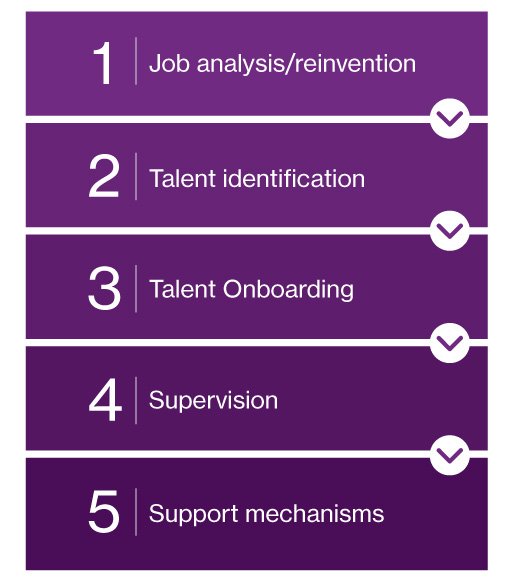The increasing importance
of redeployment
By Martin Kavanagh | June 15, 2020
As a result of the Covid-19 crisis, many organizations have put cost control measures, including recruitment freezes, in place.
Many of these organizations will have seen a significant shift in the behaviors of their customers, experiencing significant growth in demand for some of their products and services at the same time as a significant decline in demand for others. For these organizations, being able to move internal talent quickly and effectively has never been more important.
The importance of context in redeployment
How redeployment is managed is context-specific. For example, some of the businesses who have seen a significant shift in customer behavior will quickly return to the status quo when we are all fully back open for business. Others, or functions within them, may never fully recover. Therefore, in some cases, the redeployment will be temporary, and for a finite period. In other cases, the redeployment may need to be permanent.
A second key consideration is the size of the organization. Smaller businesses can typically be more fleet of foot in these situations and quickly identify where their skills lie. Larger businesses often rely on HR Information Systems and data (which may be of variable quality and completeness) to give them the information they need about talent mobility.
Is there a framework of redeployment which can help organizations regardless of their context?
It appears there is. In researching this, we looked at the guidance provided by some professional bodies/organizations who have a key interest in this topic (e.g. the CIPD; the British Psychological Society; the NHS). There was significant overlap in their recommendations which can be condensed into a five-stage redeployment process:

Across Willis Towers Watson, we have expertise and tools to help with all five of these stages, but for the purpose of this article we are focusing on Stages 1 and 2 – job analysis/reinvention and talent identification.
Job analysis/reinvention
When making decisions about talent resourcing, you need to know what skills and behaviors are required and you need to assess these using relevant measures. The job requirements need to be well understood and based on the current, and future, demands of the role. If you are reviewing the requirements of a role, job reinvention could be key. Before making the decision to redeploy, you should take the opportunity to make sure you are delivering the work in the most effective way.
We offer WorkVue to support clients with this process. WorkVue is AI-driven software designed to reinvent jobs to achieve the optimal combination of talent and automation. In Stage 2, this can help make sure that you are identifying the talent you need now rather than the talent you think you need or have needed in the past.
Talent identification
All of the professional bodies and organizations who share guidance on redeployment stress the importance of making sure individuals can competently do a job. At Saville Assessment, we look at two aspects which are relevant here – does someone have the talent to do the job and do they have the motives to do the job?
Organizations need to make sure that any redeployed individuals meet the minimum requirements for the role (e.g. have the necessary qualifications) and have the cognitive ability to meet the demands of the role. Smaller organizations may well have an informal way of identifying who meets the minimum requirements for a particular role. For larger organizations, SkillsVue may be the answer. SkillsVue’s core function is to benchmark premiums for skills for compensation executives. It does, however, also offer skills catalogue functionality which can be integrated with other HR Information Systems to quickly and easily identify those who would meet the minimum requirements for a job. In terms of understanding cognitive ability, Saville Assessment offer a range of cognitive ability tests for this purpose.
We have written a number of articles on the importance of using our suite of behavioral assessments in talent identification as they can be used to understand a candidate’s talents and motives in relation to a particular role. Behavioral assessment is arguably even more important in redeployment situations where people may well be asked to move to a role which isn’t a natural part of their career plan. If they don’t have the behavioral fit with the role, the move is unlikely to work and, even in redeployment situations, a ’wrong hire’ can be very costly. Saville Assessment offer a range of behavioral assessments designed for candidate matching, with completion times from just 6.5 minutes. Again, these can be integrated with applicant tracking systems to allow you to quickly assess who is most likely to thrive and excel in a role.
How could this work in practice?
Here is how the talent identification stage could look in your organization:
- Using the skills catalogue functionality in SkillsVue, you will have identified those in the organization who meet the essential requirements of the job description.
- You would ask this pool of individuals to complete Match 6.5 (behavioral assessment with a 6.5-minute completion time) and a Swift Aptitude assessment (combined aptitude test with a 9.5- to 18-minute completion time depending on the level of the role) to make sure they will be able to deal with the cognitive demands of the role and have the behavioral fit which means they are likely to thrive.
- Depending on the stakes of the role, you may also decide to run a virtual assessment using our ’validity-optimized’ approach to final-stage assessment design. This would include a highly-structured interview and job-relevant exercise to assess technical skills and can be easily delivered virtually.
What does this mean for redeployment?
Imagine how slick your redeployment process could be if you had a clear means of identifying what you need from a role and those with the talents and motives to excel. It is surprising how many organizations move their talent around without taking this level of care to ensure they end up with an opportunity they will value and make the most of. At a time when our employee experience surveys are showing 92% of the workforce are reporting at least some anxiety from the coronavirus, and 55% are indicating a moderate or high degree of anxiety, it is critical we all focus on the employee experience and getting redeployment right.

Author
Martin Kavanagh
Managing Consultant
Saville Assessment, a Willis Towers Watson Company
Martin is a Chartered Occupational Psychologist with over 10 years’ experience in talent assessment. Having spent a number of years in a recruitment process outsourcing consultancy, Martin has significant experience in supporting some of the world’s biggest recruiters improve their candidate selection processes. Follow Martin on LinkedIn or Twitter.